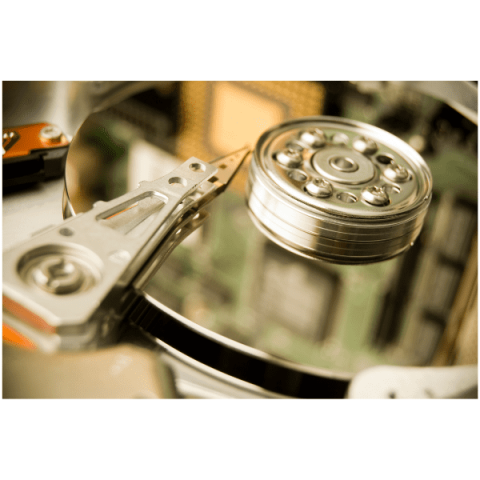The disk, often referred to as the “hard drive”, is one of the fundamental components of a computer. It is where the files we save on the machine are stored.
In most cases, it also contains the operating system (Windows, Linux, among others) and all the other programs installed on the computer.
Even the most modern computers with SSDs can’t do without a disk, which is used to store large files, as its storage capacity is always much greater than other technologies.
However, a disk has a lifespan which, unfortunately, can be shortened due to various factors, such as the temperature of the computer, improper use of the machine, incompatibilities between software and hardware, among others.
This is why in this article we are going to look at some ways of identifying whether your disk has a problem and whether it should be replaced soon or not.
Remember: if you suspect that your disk may be faulty, don’t hesitate to back up your files before it’s too late!

6 tips to identify if your disk is defective
1. The disk is slow or crashes frequently
Slowness when opening files and programs can be a sign that something is wrong with the disk. In addition, frequent crashes can also be an indication that the hard disk is in trouble.
However, these same signs can appear due to various other problems, so you can’t be sure from this alone that the disk is the problem.
Even so, this can be a first sign to invite a more detailed analysis of the problems your computer is facing.
In addition to slowdowns and breaks, it is also possible to see the infamous “blue screen of death”, a screen with a blue background that appears unexpectedly while the computer is in use and makes it unusable until it is restarted.
An increase in the computer’s temperature can also indicate a disk problem, as it means that the machine is using a lot of resources trying to find the files and/or programs and crashing repeatedly.
2. Data is being corrupted
Corrupted data appearing very frequently can be a sign that there are problems with the disk, especially if the part is more than five years old.
Corrupted data can manifest itself in the following ways:
- Disappearance of files and programs;
- Errors in downloads and installations;
- Corrupt file messages.
3.Strange noises and sounds
The disk is a part that has a mechanical arm and a needle that records the data on the disk. In normal operation, it doesn’t usually make very noticeable noises.
However, if your computer has been making different noises for a while, as well as other signs of disk failure (such as those mentioned in this article), you may suspect that there is something wrong with the hard disk.
This type of problem tends to arise more frequently in laptops, which are often moved around, leaving the components more prone to drops, knocks and other situations that can cause physical damage to the machine.
4. Windows doesn’t recognize the disk
In this case, it may not be the disk that is the problem, but the operating system that has an error or there is a problem with the cables or the connection to the motherboard.
However, this doesn’t mean that everything is fine with the disk, as Windows tends to “disregard” a defective disk, failing to recognize it.
To better understand the nature of this error, it is important to look out for other signs that the disk is failing.
You can also test the disk on another machine. If it works properly on the other machine and doesn’t make any strange noises, the problem is probably with the machine and not the hard disk. But if it still doesn’t recognize that it really is a disk problem and you need the data on the disk, consider talking to us.
5. Bad Blocks
Bad blocks can be defined as “damaged sectors” on the hard disk. This stops files from being stored correctly, as well as impairing their reading and execution.
One of the big problems with bad blocks is that they tend to form more bad blocks, further damaging the hard disk’s storage capacity.
Bad blocks can be of physical or software origin. Physical bad blocks are caused by physical damage to the disk, which is more difficult to recover than software bad blocks.
Physical damage to the hard disk can be caused by knocks that damage the part, exposure to high temperatures, dust entering the sealed area of the disk, etc.
Software bad blocks, on the other hand, are related to malicious software, such as viruses, or even basic carelessness, such as turning the machine off incorrectly.
To avoid them, always try to shut down your computer properly and avoid downloading suspicious files and programs from unknown sources.
The good thing, however, is that in some cases it is possible to “isolate” the bad blocks and continue to use the disk, but with a more limited storage capacity.
If in doubt, consult a specialist for a more precise analysis of the problem and how to solve it.
6. Use a diagnostic app
If you are unsure of what might be going on with your computer, there are several diagnostic applications that can help you find out if something is faulty.
Some alternatives include CrystalDiskInfo, GSmart Control, diskDScan, diskTune, among others. However, these applications are not a substitute for an expert assessment and may not be accurate enough to detect problems that are in their infancy.
Windows also has a native tool that helps with diagnostics, known as “Chkdsk”. To use it, follow these steps:
- Open File Explorer;
- Go to “My Computer” or “This Computer”;
- Under “Devices and Drives”, right-click on the driver that represents your disk;
- Select “Properties”;
- Go to the “Tools” tab;
- In the “Error checking” section, click on “Check”;
- Windows detects any errors, the Windows Event Viewer tool will notify you.
It is worth noting that this method can also help with some minor problems, as during the scan it already fixes some bugs and other problems that can be resolved automatically.
How can these problems be avoided?
It is not always possible to avoid the deterioration of computer parts, especially if they are already old. However, it is possible to extend their useful life by following these simple tips:
- Keep your computer in a clean and airy environment, occasionally opening it to remove the dust that accumulates inside (if in doubt, ask a specialist for help);
- Always check the cables connected to the machine, as problems with these can end up damaging the disk;
- Check that the disk is seated in the correct position;
- Install a good antivirus, keep it updated and scan it frequently to avoid malware;
- Make sure you only install programs that come from a trusted source;
- When transporting your computer, whether it is a desktop or a laptop, be careful to avoid drops and knocks, as the impact can damage the internal parts.
Conclusion
Computers are complex machines and problems with any of their components can be difficult to detect.
The purpose of this article is to help you come up with a diagnosis of the problem, but it is not a substitute for a professional assessment.
If you need to recover data from a faulty disk, talk to Bot. We have over a decade of experience in recovering data from defective disks and over 100,000 successful cases!


